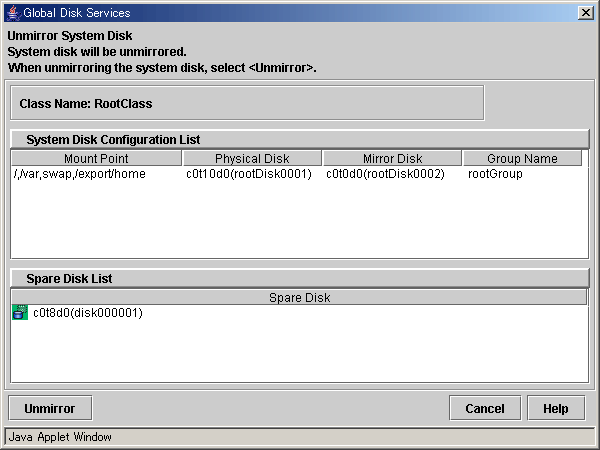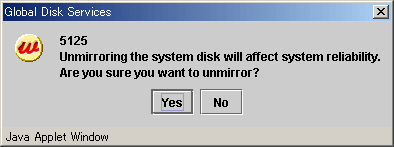In this section, how to unmirror a system disk in a UFS boot environment is explained.
Note
The removal of mirroring for a ZFS boot environment system disk cannot be performed from GDS Management View. For the cancellation method using commands, refer to "Chapter 7 How to Set and Cancel System Disk Mirroring Using Commands."
Note
When You Cannot Unmirror the System Disk
If system disks are under the following conditions, the system disks cannot be unmirrored. In these situations, restore the disk status first and unmirror the system disks.
A slice has been detached temporarily with [Detach Slice].
A disk has been disconnected with [Swap Physical Disk].
A disk is in disabled status.
All disks in each group contain a slice that is not active.
There is a proxy volume.
There is a volume to which a proxy volume is joined.
Note
For Safe Unmirroring of System Disk
To safely unmirror the system disk, exit all active applications before proceeding to cancel system disk settings.
After unmirroring the system disk is complete, promptly reboot the system in multi-user mode.
Note
[IOmonitor]
If you use the I/O Response Time Assurance Function and system panic mode is enabled for the root class, disable system panic mode for the root class before you cancel the system disk mirroring. For details on how to change the system panic mode, see "8.3.2 Changing the System Panic Mode."
Confirming system disk configuration
Select [Settings]:[Unmirror System Disk] in the Main screen. System disk mirroring configurations are displayed.
Figure 5.112 Unmirror System Disk

If unmirroring is performed, the disk displayed in the [Mirror Disk] field is disconnected and the disk displayed in the [Physical Disk] field will be used as the system disk.
Note
The disk displayed in the [Mirror Disk] field cannot be used as a system disk after unmirroring.
If the root class includes only system disks with their mirror disks and spare disks, the entire root class is removed. Here, the spare disks displayed in the spare disk field are also removed.
If the root class includes objects other than system disks, such as single disks and mirror groups, those settings are retained and only the unmirroring of system disks is executed. Here, the spare disk field does not display any information and spare disks are not be removed.
To unmirror the system disk, click <Unmirror>. To cancel the unmirroring operation, click <Cancel>.
Confirming the unmirroring of system disk
If you click <Unmirror > in the Unmirror System Disk screen, the screen below appears.
Figure 5.113 Unmirroring System Disk Confirmation Screen

To continue the process, click <Yes>. Clicking <No> cancels the system disk unmirroring process.
Unmirroring System Disk Completion screen
If you click <Yes> on the Unmirroring System Disk Confirmation screen, the screen below appears.
Figure 5.114 Unmirroring System Disk Completion Screen

Confirm that unmirroring of system disk is complete and click <OK>.
Figure 5.115 System Reboot Notification Screen

The unmirroring of system disks will take place when the system is rebooted in multi-user mode.
Click <OK> and reboot the system in multi-user mode immediately.
Note
To stop or reboot the system immediately after rebooting the system, check the sdxinfo(1) command output to see whether the system disk has already been unmirrored in advance.